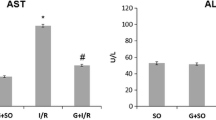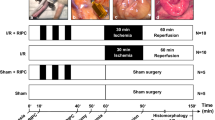Abstract
Purpose
Creatine belongs to a buffering system of cellular ATP level and has been reported to display direct antioxidant activity. Aim of this work was to investigate whether creatine treatment could ameliorate the antioxidant response of intestinal cells and limit the oxidative injury induced by anoxia and subsequent reoxygenation.
Methods
Jejunal and ileal tracts of rat intestine were everted and incubated in vitro under normoxic, anoxic and reoxygenation conditions in the absence and in the presence of 10 mM creatine. (Na+, K+)-ATPase, γ-GT and antioxidant enzymes activities were determined in mucosal homogenate, as well as malondialdehyde production and HSP70 expression.
Results
Both in jejunum and ileum, creatine treatment increases (Na+, K+)-ATPase activity; γ-GT is unaffected in jejunum but stimulated in ileum. In both tissues, creatine does not alter the antioxidant activities or malondialdehyde level. HSP70 expression is increased only in jejunum. Anoxic conditions stimulate antioxidant activities to a greater extent in jejunum compared to ileum; reoxygenation does not evoke further effects, but enhances malondialdehyde production in both tracts. The protective action of creatine, in reoxygenation, is more marked in jejunum as for its stimulation of antioxidant activities; however, in jejunum, a prooxidant action of creatine is suggested, since malondialdehyde production is enhanced by its presence; on the contrary in ileum, where HSP70 is overexpressed in reoxygenation, peroxidation level is significantly reduced.
Conclusions
The presence of creatine seems to potentiate the defensive response of both tissues, in jejunum by means of cell antioxidant equipment, in ileum by the involvement of HSP70.





Similar content being viewed by others
References
Wyss M, Kaddurrah-Daouk R (2000) Creatine and creatinine metabolism. Physiol Rev 80:1107–1213
Walker J (2001) Creatine: biosynthesis, regulation and function. Adv Enzym 50:177–242
Persky AM, Brazeau GA (2001) Clinical pharmacology of the dietary supplement creatine monohydrate. Pharmacol Rev 53:161–176
Snow RJ, Murphy RM (2001) Creatine and the creatine transporter: a review. Mol Cell Biochem 224:169–181
Tosco M, Faelli A, Sironi C, Gastaldi G, Orsenigo MN (2004) A creatine transporter is operative at the brush border level of rat jejunal enterocyte. J Membrane Biol 202:85–95
Orsenigo MN, Faelli A, De Biasi S et al (2005) Jejunal creatine absorption: what is the role of the basolateral membrane? J Membrane Biol 207:183–195
Ferrante RJ, Andreassen OA, Jenkins BG et al (2000) Neuroprotective effects of creatine in a transgenic mouse model of Huntington’s disease. J Neurosci 20:4389–4397
Tarnopolsky MA, Parshad A, Walzel B et al (2001) Creatine transporter and mitochondrial creatine kinase protein content in myopathies. Muscle Nerve 24:682–688
Beal MF (2003) Bioenergetic approaches for neuroprotection in Parkinson’s disease. Ann Neurol 53:539–548
Davidson ZE, Truby H (2009) A review of nutrition in Duchenne muscular dystrophy. J Hum Nutr Diet 22:383–393
Rambo LM, Ribeiro LR, Oliveira MS et al (2009) Additive anticonvulsant effects of creatine supplementation and physical exercise against pentylenetetrazol-induced seizures. Neurochem Int 55:333–340
Gilgun-Sherki Y, Melamed E, Offen D (2004) The role of oxidative stress in the pathogenesis of multiple sclerosis: the need for effective antioxidant therapy. J Neurol 251:261–268
Kovacic P, Thurn LA (2005) Cardiovascular toxicity from the perspective of oxidative stress, electron transfer, and prevention by antioxidants. Curr Vasc Pharmacol 3:107–117
Perrin RJ, Fagan AM, Holtzman DM (2009) Multimodal techniques for diagnosis and prognosis of Alzheimer’s disease. Nature 461:916–922
Lawler JM, Barnes WS, Wu G et al (2002) Direct antioxidant properties of creatine. Biochem Biophys Res Commun 290:47–52
Sestili P, Barbieri E, Martinelli C et al (2009) Creatine supplementation prevents the inhibition of myogenic differentiation in oxidatively injured C2C12 murine myoblasts. Mol Nutr Food Res 53:1187–1204
Sestili P, Martinelli C, Bravi G et al (2006) Creatine supplementation affords cytoprotection in oxidatively injured cultured mammalian cells via direct antioxidant activity. Free Rad Biol Med 40:837–849
Dröge W (2002) Free radicals in the physiological control of cell function. Physiol Rev 82:47–95
Sasaki M, Joh T (2007) Oxidative stress and ischemia-reperfusion injury in gastrointestinal tract and antioxidant, protective agents. J Clin Biochem Nutr 40:1–12
Blachier F, Boutry C, Bos C, Tomé D (2009) Metabolism and functions of L-glutamate in the epithelial cells of the small and large intestines. Am J Clin Nutr 90:814S–821S
Qian W, Nishikawa M, Haque AM et al (2005) Mitochondrial density determines the cellular sensitivity to cisplatin-induced cell death. Am J Physiol Cell Physiol 289:C1466–C1475
Faelli A, Burlini N, Esposito G et al (1979) The rat and hamster jejunum during transintestinal transport in vitro. Arch Int Physiol Biochem 87:73–86
Bradford MN (1976) A rapid and sensitive method for the quantitation of microgram quantities of protein utilizing the principle of proteine-dye-binding. Anal Biochem 72:248–254
Schöner W, Von Ilberg C, Kramer R, Seubert W (1967) On the mechanism of Na+ and K+ stimulated hydrolysis of adenosine triphosphate. Purification and properties of Na+ and K+ activated ATPase from ox brain. Eur J Biochem 1:334–343
Persijn JP, Van Der Slik W (1976) A new method for the determination of γ-glutamyltransferase in serum. J Clin Chem Clin Biochem 14:421–427
Aebi HE (1983) Catalase. In: Bergmeyer HU (ed) Methods in enzymatic analysis. Verlag Chemie, Weinhiem, pp 278–282
Guzik TJ, Olszanecki R, Sadowski J et al (2005) Superoxide dismutase activity and expression in human venous and arterial bypass graft vessels. J Physiol Pharmacol 56:313–323
Anwer T, Sharm M, Pillai KK et al (2007) Protective effect of bezafibrate on streptozomicin-induced oxidative stress and toxicity in rats. Toxicol 229:165–172
Ojano-Dirain C, Iqbal M, Wing T et al (2005) Glutathione and respiratory chain complex activity in duodenal mitochondria of broilers with low and high feed efficiency. Poultry Sci 84:782–788
Ohkawa H, Ohishi N, Yagi K (1979) Assay for lipid peroxides in animal tissues by thiobarbituric acid reaction. Anal Biochem 95:351–358
Ohkawara T, Nishihira J, Nagashima R et al (2006) Polaprezinc protects human colon cells from oxidative injury induced by hydrogen peroxide: relevant to cytoprotective heat shock proteins. World J Gastroenterol 12:6178–6181
Sepponen K, Pösö AR (2006) The inducible form of heat shock protein 70 in the serum, colon and small intestine of the pig: comparison to conventional stress markers. Vet J 171:519–524
Yildiz F, Terzi A, Coban S et al (2009) Protective effects of resveratrol on small intestines against intestinal ischemia-reperfusion injury in rats. J Gastroenterol Hepatol 24:1781–1785
Levy E, Trudel K, Bendayan M et al (2007) Biological role, protein expression, subcellular localization, and oxidative stress response of paraoxonase 2 in the intestine of humans and rats. Am J Physiol Gastrointest Liver Physiol 293:G1252–G1261
Turan A, Mahmood A (2007) The profile of antioxidant systems and lipid peroxidation across the crypt-villus axis in rat intestine. Dig Dis Sci 52:1840–1844
McLeana JA, Karadasb F, Suraic PF et al (2005) Lipid-soluble and water-soluble antioxidant activities of the avian intestinal mucosa at different sites along the intestinal tract. Comp Biochem Physiol B 141:366–372
Gimenez-Crouseilles J, Puig-Parellada P (2010) Pharmacologically induced ischemia-reperfusion syndrome in the rat small intestine. J Surg Res doi:10.1016/j.jss.2010.02.022
Walshe TE, D’Amore PA (2008) The role of hypoxia in vascular injury and repair. Annu Rev Pathol Mech Dis 3:615–643
Haglund U (1994) Gut ischaemia. Gut 35:S73–S76
Wang QS, Zhang CL, Zhao XL et al (2006) Malondialdehyde and catalase as the serum biomarkers of allyl chloride-induced toxic neuropathy. Toxicology 227:36–44
de Oliveira MR, de Bittencourt Pasquali MA, Bristot Silvestrin R et al (2007) Vitamin A supplementation induces a prooxidative state in the striatum and impairs locomotory and exploratory activity of adult rats. Brain Res 1169:112–119
Zheng MQ, Tang K, Zimmerman MC et al (2009) Role of gamma-glutamyl transpeptidase in redox regulation of K+ channel remodeling in postmyocardial infarction rat hearts. Am J Physiol Cell Physiol 297:253–262
Cuzzocrea S, Mazzon E, Dugo L et al (2001) Protective effects of a new stable, highly active SOD mimetic, M40401 in splanchnic artery occlusion and reperfusion. Brit J Pharmacol 132:19–29
Meyer LE, Machado LB, Santiago AP et al (2006) Mitochondrial creatine kinase activity prevents reactive oxygen species generation: antioxidant role of mitochondrial kinase-dependent ADP re-cycling activity. J Biol Chem 281:37361–37371
Perron NR, Brumaghim JL (2009) A review of the antioxidant mechanisms of polyphenol compounds related to iron binding. Cell Biochem Biophys 53:75–100
Acknowledgments
This research was supported by Ministero dell’Istruzione, dell’Università e della Ricerca, Italy.
Author information
Authors and Affiliations
Corresponding author
Rights and permissions
About this article
Cite this article
Orsenigo, M.N., Porta, C., Sironi, C. et al. Effects of creatine in a rat intestinal model of ischemia/reperfusion injury. Eur J Nutr 51, 375–384 (2012). https://doi.org/10.1007/s00394-011-0222-3
Received:
Accepted:
Published:
Issue Date:
DOI: https://doi.org/10.1007/s00394-011-0222-3




